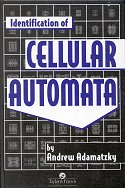
![[attractor basin]](../_misc/p974.gif) glider
as a "localised propagating structure" -- example of
self-organisation • search looks at variance of input entropy over
time • measures: maps of attractor basins -- bushy sub-trees with
high in-degree => high convergence and order, sparse sub-trees =>
low convergence and chaos; G density (Garden-of-Eden state
density), ratio of increase of G density with size: order is
high, chaos is low; distribution of in-degree size; Z parameter
-- statistical predictor of convergence: Z=0 => order, Z=1
=> chaos; • local measures (on trajectory), global measures (on
attractor basin), static measures (Z) • 1D CA, binary
state, neighbourhood k=3, can represent using state value (2
colours) or neighbourhood lookup value (8 colours); with 2nd repn, if
background (commonly looked up values) is filtered, gliders can show up
better (especially if transformed to equivalent rule using larger
neighbourhood) • attractor basins diagrammed as state transition
relations [picture], by repeatedly calculating pre-image of states •
ordered rules become rarer at higher k, complex rules are rare •
gliders can have a large diameter, and a large period • compound
gliders formed from sub-gliders colliding periodically -- hierarchy
could continue without limit • classify rules using entropy of "lookup
frequency" -- order: low entropy, low variance -- complex: medium
entropy, high variance -- chaos: high entropy, low variance •
glider collision table: description of behaviour allowing some
prediction of future evolution -- neighbourhood rule table: accounts for
origin of gliders, emergence by self-organisation
glider
as a "localised propagating structure" -- example of
self-organisation • search looks at variance of input entropy over
time • measures: maps of attractor basins -- bushy sub-trees with
high in-degree => high convergence and order, sparse sub-trees =>
low convergence and chaos; G density (Garden-of-Eden state
density), ratio of increase of G density with size: order is
high, chaos is low; distribution of in-degree size; Z parameter
-- statistical predictor of convergence: Z=0 => order, Z=1
=> chaos; • local measures (on trajectory), global measures (on
attractor basin), static measures (Z) • 1D CA, binary
state, neighbourhood k=3, can represent using state value (2
colours) or neighbourhood lookup value (8 colours); with 2nd repn, if
background (commonly looked up values) is filtered, gliders can show up
better (especially if transformed to equivalent rule using larger
neighbourhood) • attractor basins diagrammed as state transition
relations [picture], by repeatedly calculating pre-image of states •
ordered rules become rarer at higher k, complex rules are rare •
gliders can have a large diameter, and a large period • compound
gliders formed from sub-gliders colliding periodically -- hierarchy
could continue without limit • classify rules using entropy of "lookup
frequency" -- order: low entropy, low variance -- complex: medium
entropy, high variance -- chaos: high entropy, low variance •
glider collision table: description of behaviour allowing some
prediction of future evolution -- neighbourhood rule table: accounts for
origin of gliders, emergence by self-organisation The book moves from abstract principles of molecular computing to the building of actual systems. The topics include the use of proteins and other molecules for information processing, molecular recognition, computation in nonlinear media, computers based on physical reaction-diffusion systems found in chemical media, DNA computing, bioelectronics and protein-based optical computing, and biosensors.
This first volume presents theoretical foundations of the future and emergent computing paradigms and architectures. The topics covered are computability, (non-)universality and complexity of computation; physics of computation, analog and quantum computing; reversible and asynchronous devices; cellular automata and other mathematical machines; P-systems and cellular computing; infinity and spatial computation; chemical and reservoir computing.
The book is the encyclopedia, the first ever complete authoritative account, of the theoretical and experimental findings in the unconventional computing written by the world leaders in the field. All chapters are self-contains, no specialist background is required to appreciate ideas, findings, constructs and designs presented. This treatise in unconventional computing appeals to readers from all walks of life, from high-school pupils to university professors, from mathematicians, computers scientists and engineers to chemists and biologists.
This second volume presents experimental laboratory prototypes and applied computing implementations. Emergent molecular computing is presented by enzymatic logical gates and circuits, and DNA nano-devices. Reaction-diffusion chemical computing is exemplified by logical circuits in Belousov-Zhabotinsky medium and geometrical computation in precipitating chemical reactions. Logical circuits realised with solitons and impulses in polymer chains show advances in collision-based computing. Photo-chemical and memristive devices give us a glimpse on hot topics of a novel hardware. Practical computing is represented by algorithms of collective and immune-computing and nature-inspired optimisation. Living computing devices are implemented in real and simulated cells, regenerating organisms, plant roots and slime mould.
The book is the encyclopedia, the first ever complete authoritative account, of the theoretical and experimental findings in the unconventional computing written by the world leaders in the field. All chapters are self-contains, no specialist background is required to appreciate ideas, findings, constructs and designs presented. This treatise in unconventional computing appeals to readers from all walks of life, from high-school pupils to university professors, from mathematicians, computers scientists and engineers to chemists and biologists.
Thanks, everyone!